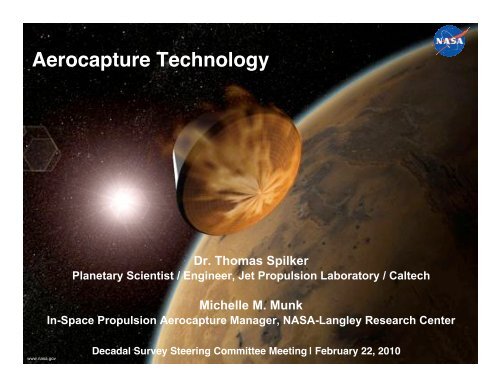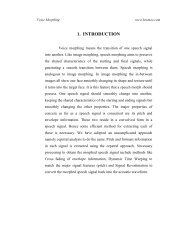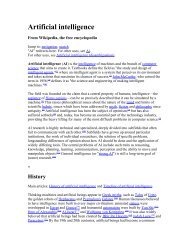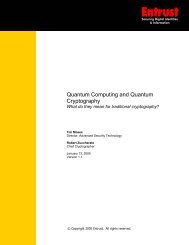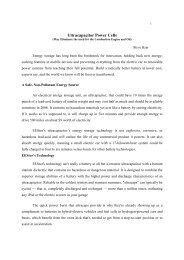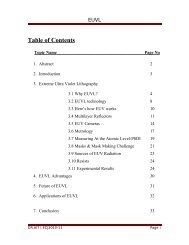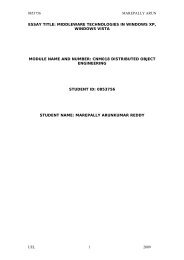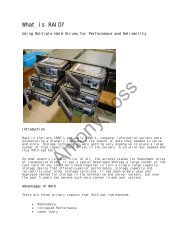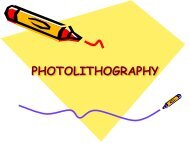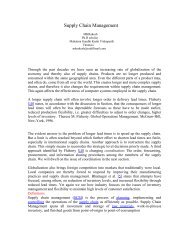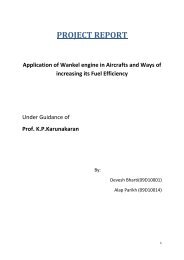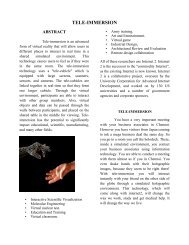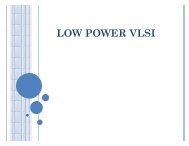Aerocapture Technology - 123SeminarsOnly
Aerocapture Technology - 123SeminarsOnly
Aerocapture Technology - 123SeminarsOnly
You also want an ePaper? Increase the reach of your titles
YUMPU automatically turns print PDFs into web optimized ePapers that Google loves.
<strong>Aerocapture</strong> <strong>Technology</strong><br />
www.nasa.gov<br />
Dr. Thomas Spilker<br />
Planetary Scientist / Engineer, Jet Propulsion Laboratory / Caltech<br />
Michelle M. Munk<br />
In-Space Propulsion <strong>Aerocapture</strong> Manager, NASA-Langley Research Center<br />
Decadal Survey Steering Committee Meeting | February 22, 2010<br />
1
Introduction to <strong>Aerocapture</strong><br />
Mission Benefits / Missions Enabled<br />
Current Status of <strong>Aerocapture</strong><br />
Plan and Costs to Flight<br />
Outline<br />
2
Atmospheric<br />
Drag<br />
Reduces Orbit<br />
Period<br />
Hyperbolic<br />
Approach<br />
Aerobraking<br />
Orbit<br />
Insertion<br />
Burn<br />
Aerobraking vs <strong>Aerocapture</strong><br />
Many Passes<br />
Through Upper<br />
Atmosphere<br />
Entry<br />
targeting<br />
burn<br />
Periapsis<br />
raise<br />
maneuver<br />
(propulsive)<br />
<strong>Aerocapture</strong><br />
Jettison<br />
Aeroshell<br />
Energy<br />
dissipation/<br />
Autonomous<br />
guidance<br />
Target<br />
orbit<br />
<strong>Aerocapture</strong>: A vehicle uses active<br />
control to autonomously guide itself<br />
to an atmospheric exit target,<br />
establishing a final, low orbit about a<br />
body in a single atmospheric pass.<br />
3
The !V necessary to slow from a<br />
hyperbolic approach trajectory to a<br />
useful science orbit is<br />
!V = V phyp - V circ<br />
The rocket equation shows why<br />
aerocapture is so advantageous,<br />
masswise:<br />
For a propulsive capture, the mass<br />
increases exponentially with the !V;<br />
for aerocapture, the mass of the<br />
aeroshell is linear with !V.<br />
The <strong>Aerocapture</strong> Advantage<br />
Examples for Circular Orbit Insertion<br />
Mars<br />
Titan<br />
Venus<br />
Neptune<br />
Saturn<br />
4
<strong>Aerocapture</strong>’s Advantages to Science<br />
• Advantage: greater delivered mass into orbit at the<br />
destination<br />
• It’s all about mass – more mass yields better science<br />
• More instruments, or higher-performance instruments<br />
• More mass for higher-performance subsystems that support the<br />
science<br />
• Power – for the instruments, and other support subsystems<br />
• Telecommunications – to downlink larger data volumes<br />
• Propulsion – to get the spacecraft to locations it wouldn’t access<br />
otherwise<br />
• Onboard data storage<br />
• Etc…<br />
• Structure – to hold all this together<br />
• Advantage: reduced trip times to distant destinations<br />
• Spend less time in the cruise phase, more in the science phase<br />
• Stay within the lifetimes of lifetime-limited components<br />
5
Sample <strong>Aerocapture</strong> Benefits for Robotic Missions<br />
Mission - Science Orbit<br />
Nominal<br />
Orbit<br />
Insertion<br />
!V, km/s<br />
Best A/C<br />
Mass, kg<br />
Best<br />
non-A/C<br />
Mass, kg<br />
A/C %<br />
Increase<br />
Launch<br />
Vehicle<br />
Decrease?<br />
Venus V1 - 300 km circ 4.6 5078 2834 79 Yes<br />
Venus V2 - 8500 x 300 km 3.3 5078 3542 43 Yes<br />
Mars M1 - 300 km circ 2.4 5232 4556 15 No<br />
Mars M2 - ~1 Sol ellipse 1.2 5232 4983 5 No<br />
Jupiter J1 - 2000 km circ 17.0 2262
Titan <strong>Aerocapture</strong> Systems Study Concept<br />
“Titan Explorer”-type mission based on SSE<br />
Roadmap circa 2001 – direct Titan orbit<br />
Detailed analysis by multi-Center team of<br />
discipline experts (many published refs)<br />
Using <strong>Aerocapture</strong> and SEP,<br />
• fit on smaller launch vehicle<br />
• cut trip time in half<br />
versus a chemical mission.<br />
2.4 m diameter HGA<br />
3.75 m diameter<br />
Aeroshell<br />
Ref: “<strong>Aerocapture</strong> Systems Analysis for a Titan Mission”, NASA TM 2006-214273, March 2006.<br />
Lander<br />
Orbiter<br />
SEP Prop<br />
Module<br />
Solar<br />
Arrays<br />
7
Characterizing Atmospheric Uncertainties<br />
Variability We Can Model (season, latitude, etc.)<br />
Measurement Uncertainty (Big improvement for Titan after Huygens/Cassini)<br />
Residual Uncertainty (Monte-Carlo-modeled waves, turbulence, etc.)<br />
Neptune<br />
Titan<br />
Titan<br />
Mars<br />
Earth<br />
0 10 20 30 40 50 60 70<br />
Variation, % of Mean<br />
Post Cassini / Huygens<br />
Density Variation, % of Mean (at <strong>Aerocapture</strong> altitudes)<br />
• Residual uncertainty about the same for Mars and Titan; higher for Neptune<br />
• Titan’s overall variation roughly same as Earth, after Cassini/Huygens<br />
8
Trajectory Simulations Include Realistic Global<br />
Reference Atmosphere Models<br />
Global Reference Atmosphere<br />
Models (GRAM)<br />
• Provides atmosphere parameters<br />
(density, pressure, temperature)<br />
vs. altitude, latitude, longitude,<br />
season, and time of day<br />
• Earth GRAM used for Space<br />
Shuttle, Genesis, Stardust<br />
• Mars GRAM used for Pathfinder,<br />
MER, MGS, Odyssey, MRO, MSL<br />
• Titan, Neptune, Venus GRAM<br />
modeled using same approach<br />
as Mars GRAM<br />
• Titan GRAM profiles validated<br />
against Cassini/Huygens<br />
measurements<br />
Models include variability and<br />
random perturbations for Monte<br />
Carlo trajectory analysis<br />
• Includes uncertainties in current<br />
estimates derived from scientific<br />
measurements<br />
• Includes perturbations based on<br />
models of dynamic processes<br />
2000 Perturbed Density Profiles<br />
from Mars GRAM<br />
Aerobraking Altitudes<br />
<strong>Aerocapture</strong><br />
Altitudes<br />
9
Titan-GRAM Model vs Cassini-Huygens Data<br />
<strong>Aerocapture</strong><br />
min alt<br />
<strong>Aerocapture</strong> Minimum Alt Range <strong>Aerocapture</strong> to Orbit Alt Range<br />
Titan-GRAM conservatively bounds the density observations<br />
from HASI and INMS<br />
Ref.: Justh and Justus, “Comparisons of Huygens Entry Data and Titan Remote Sensing Observations with the<br />
Titan Global Reference Atmospheric Model (Titan-GRAM)”<br />
10
!<br />
!<br />
!<br />
!<br />
!<br />
!<br />
!<br />
Titan <strong>Aerocapture</strong> Technologies - Ready!<br />
Enabling Technologies - No new enabling technology required<br />
Strongly Enhancing Technologies<br />
Aeroheating methods development, validation<br />
• Large uncertainties existed at time of analysis, further work and Cassini data all but<br />
eliminated<br />
TPS Material Testing<br />
• TPS materials were not tested against then-expected radiative heating at Titan;<br />
testing was done AND radiative environment reduced significantly in models<br />
Atmosphere Modeling<br />
• Model validated against Cassini/Huygens data<br />
Enhancing Technologies<br />
Aeroshell lightweight structures - reduced aerocapture mass<br />
Guidance - Existing guidance algorithms have been demonstrated to<br />
provide acceptable performance, improvements could provide<br />
increased robustness<br />
Simulation - Huygens trajectory reconstruction, statistics and modeling<br />
upgrades<br />
Mass properties/structures tool - systems analysis capability<br />
improvement, concept trades<br />
11
300 x 300 km<br />
<strong>Aerocapture</strong> Benefit for a Venus Mission<br />
1165 kg Launch Vehicle Capability<br />
Delta 2925H-10, C3 = 8.3 km 2 /s 2<br />
Into 300 x 300 km Venus orbit with same launch vehicle, <strong>Aerocapture</strong> delivers:<br />
• 1.8x more mass into orbit than aerobraking<br />
• 6.2x more mass into orbit than all chemical<br />
Reference: “Systems Analysis for a Venus <strong>Aerocapture</strong> Mission”, NASA TM 2006-214291, April 2006<br />
Mass savings will<br />
scale up for<br />
Flagship-class<br />
mission<br />
Venus Orbiter<br />
(OML Design Only)<br />
Ø 2.65 m<br />
12
Example Monte Carlo Simulation Results:<br />
Venus <strong>Aerocapture</strong><br />
100%<br />
successful<br />
capture<br />
97.7% !V performed<br />
by <strong>Aerocapture</strong><br />
13
Neptune Orbiter <strong>Aerocapture</strong> System Concept<br />
Mass margin provides opportunity for<br />
• Third probe<br />
• Increased aeroshell size for possible reduction in<br />
aeroheating rates/loads, TPS thickness<br />
requirements, surface recession<br />
Propulsive mission is too massive for Delta IV-H<br />
<strong>Aerocapture</strong> is ENABLING<br />
Orbiter<br />
2.88 m Length<br />
Flattened Ellipsled<br />
Aeroshell<br />
2 Probes<br />
Orbiter<br />
Reference: “Systems Analysis for a Neptune <strong>Aerocapture</strong> Mission”, NASA TM 2006-214300, May 2006<br />
35% Dry<br />
Margin at<br />
Orbiter and<br />
SEP Level<br />
5m Fairing<br />
Solar<br />
arrays<br />
SEP Prop<br />
Module<br />
14
Total Heat Load (kJ/cm 2 )<br />
1.6<br />
1.4<br />
1.2<br />
1.0<br />
.8<br />
.6<br />
.4<br />
.2<br />
0<br />
Neptune <strong>Aerocapture</strong> Challenges: Aeroheating, TPS<br />
Zone 4<br />
(includes<br />
base)<br />
Low<br />
Zone 2<br />
2.88 m<br />
Zone 2 – Wind<br />
TPS Sizing<br />
Radiative<br />
Convective<br />
Ref<br />
Med<br />
Zone 3<br />
High<br />
Outside of<br />
Expected Range<br />
Zone 1<br />
~0.74 m<br />
16<br />
14<br />
12<br />
10<br />
8<br />
6<br />
4<br />
2<br />
0<br />
Total Peak Heat Rate (kW/cm 2 )<br />
• TPS developments and interfaces<br />
will require a significant effort<br />
• No facility exists for testing these<br />
heating levels, or the combined<br />
convective/radiative environment<br />
• Manufacturing and shape change<br />
due to recession is challenging<br />
• New aerodynamic shape<br />
Total Heat Load (kJ/cm 2 )<br />
4.0<br />
3.5<br />
3.0<br />
2.5<br />
2.0<br />
1.5<br />
1.0<br />
.5<br />
0<br />
Zone 1 – Nose<br />
TPS Sizing<br />
Radiative<br />
Convective<br />
Low<br />
Ref<br />
Med<br />
High<br />
Outside of<br />
Expected Range<br />
40<br />
35<br />
30<br />
25<br />
20<br />
15<br />
10<br />
5<br />
0<br />
Total Peak Heat Rate<br />
(kW/cm2 )<br />
15
Top-Level <strong>Aerocapture</strong> Infusion Roadmap<br />
In-Space Propulsion <strong>Technology</strong><br />
(2002+)<br />
Systems Analysis<br />
<strong>Technology</strong> Development<br />
Aeroshells and TPS<br />
Aerothermal Models<br />
Guidance, Navigation and Control<br />
Instrumentation<br />
Additional development:<br />
Aerothermal<br />
TPS/test facilities<br />
Aerodynamics<br />
Structures/manufacturing<br />
Earth Orbit Flight<br />
Test (2015)<br />
Inner Planet/OP Satellite<br />
<strong>Aerocapture</strong> Missions (2018+)<br />
(Low L/D, modest TPS needs)<br />
Mars Titan<br />
Venus<br />
Additional development:<br />
Aerothermal<br />
TPS/test facilities<br />
Aerodynamics<br />
Structures/manufacturing<br />
Giant Planet <strong>Aerocapture</strong> Missions (2025+)<br />
(High L/D, substantial TPS needs)<br />
Jupiter Saturn Uranus Neptune
ISPT’s Low-Risk Aeroshell Mass Improvements<br />
Warm Structure System Model - based on MER, MPF, validated with testing<br />
For environments up to 300 W/cm2 HT-424<br />
for adhesive<br />
Aluminum<br />
honeycomb<br />
MER SLA-561V System 250 deg C<br />
Areal Density = 2.07 lb/ft 2 Areal Density = 1.78 lb/ft 2<br />
Genesis Carbon-Carbon<br />
Warm Structure SLA-561V System 316 deg C<br />
Hot Structure System Model - based on Genesis, validated with testing<br />
For environments up to 700 W/cm2 Final System included<br />
backup aluminum<br />
Honeycomb structure<br />
Modified RS9<br />
for adhesive<br />
Graphite polycyanate<br />
honeycomb<br />
Final System includes<br />
11-layer MLI<br />
and high-temp coating<br />
Hot Structure<br />
Carbon-Carbon/Calcarb<br />
Areal Density = 3.65 lb/ft 2 Areal Density = 2.50 lb/ft 2<br />
14%<br />
Improvement<br />
31%<br />
Improvement<br />
17
Aeroshell Manufacture and Test with Ablator<br />
Family System<br />
ARA Material Density Heating Range New Missions Features<br />
SRAM-17 0.27 g/cm 2 115 – 210 W/cm 2 Titan, Mars Robust Char<br />
SRAM-20 0.32 g/cm 2 140 – 260 W/cm 2 Earth Acap, Mars Low Recession<br />
PhenCarb-20 0.32 g/cm 2 200 – 500 W/cm 2 Large Mars, EEV High Heating<br />
PhenCarb-32 0.51 g/cm 2 500 – 1,100 W/cm 2 EEV, Venus, Neptune Severe Heating<br />
1-m SRAM-20 aeroshell test at Solar Tower<br />
18
Power<br />
Supply<br />
Command &<br />
Telemetry<br />
Processing<br />
Main<br />
Simulation<br />
Processor<br />
Simulation I/O<br />
Cards for IMU<br />
& Thrusters<br />
GN&C Flight Testbed is Complete<br />
Spacecraft Computer with MOAB<br />
Card (Broad Reach Engineering)<br />
Command & Telemetry<br />
Workstation<br />
19
Status of <strong>Aerocapture</strong> <strong>Technology</strong><br />
• ISPT has made major strides in ground-based<br />
development over the past 8 years<br />
• GN&C Hardware-in-the-Loop Testbed (guidance coded in flight<br />
software)<br />
• Lighter, more robust structural and TPS concepts matured through<br />
arcjet, structural, and environmental testing and model validation,<br />
culminating in two 2-meter and larger aeroshell manufacturing<br />
demonstrations<br />
• Aerothermal and Atmospheric models greatly matured (better<br />
prediction capability)<br />
• High-fidelity statistical simulation capability applied to several<br />
destinations (same tool used for operational planetary entry<br />
missions)<br />
• Stoplight chart on next page show summary of “readiness”<br />
of each subsystem for key destinations<br />
20
Destination<br />
Subsystem<br />
Atmosphere<br />
Goal: Capture Physics<br />
Aerodynamics<br />
Goal: Errors ! 2%<br />
GN&C<br />
Goal: Robust<br />
performance for 4-6<br />
DOF simulations<br />
TPS<br />
Goal: Reduce SOA by<br />
30%+, expand TPS<br />
choices<br />
Structures<br />
Goal: Reduce SOA<br />
mass by 25%<br />
Aerothermal<br />
Goal: Models match<br />
within 15%<br />
System<br />
Goal: Robust<br />
performance with<br />
ready technology<br />
Venus-GRAM (2004)<br />
based on world-wide<br />
VIRA.<br />
Heritage shape, well<br />
understood aerodynamics<br />
CA =±3%, CN =±5%,<br />
" TRIM =±2%<br />
APC algorithm captures<br />
96% of corridor<br />
More testing needed on<br />
efficient mid-density TPS.<br />
Combined convective<br />
and radiative facility<br />
needed.<br />
High-temp systems will<br />
reduce mass by 31%.<br />
Convective models<br />
match within 20% laminar,<br />
45% with turbulence.<br />
Radiative models agree<br />
within 50%<br />
Accomplishes 97.7% of<br />
!V to achieve 300 x 300<br />
km orbit.<br />
<strong>Aerocapture</strong> <strong>Technology</strong> Subsystem<br />
Readiness<br />
Venus Earth Mars Titan Neptune<br />
Earth-GRAM (1974)<br />
validated by Space Shuttle<br />
Heritage shape, well<br />
understood aerodynamics<br />
CA =±3%, CN =±5%,<br />
" TRIM =±2%<br />
Small delivery errors. APC<br />
algorithm captures 97% of<br />
corridor<br />
<strong>Technology</strong> ready for ST9.<br />
LMA hot structure ready for<br />
arrivals > 10.5 km/s.<br />
High-temp systems will<br />
reduce mass by 14%-30%.<br />
Environment fairly wellknown<br />
from Apollo, Shuttle.<br />
Models match within 15%<br />
Accomplishes 97.2% of !V<br />
to achieve 300 x 130 km<br />
orbit. No known<br />
technology gaps.<br />
Mars-GRAM (1988)<br />
continuously updated with<br />
latest mission data.<br />
Heritage shape, well<br />
understood aerodynamics<br />
CA =±3%, CN =±5%,<br />
" TRIM =±2%<br />
Small delivery errors using<br />
!DOR. APC algorithm<br />
captures 99% of corridor<br />
ISPT investments have<br />
provided more materials<br />
ready for application to<br />
slow arrivals, and new<br />
ones for faster entries.<br />
High-temp systems will<br />
reduce mass by 14%-<br />
30%.<br />
Convective models agree<br />
within 15%. Radiative:<br />
predict models will agree<br />
within 50% where radiation is<br />
a factor.<br />
Accomplishes 97.8% of<br />
!V to achieve 1400 x 165<br />
km orbit. No known<br />
technology gaps.<br />
Titan-GRAM (2002) based on<br />
Yelle atmosp. Accepted<br />
worldwide to be updated with<br />
Cassini-Huygens data<br />
Heritage shape, well<br />
understood aerodynamics<br />
CA =±3%, CN =±5%,<br />
" TRIM =±2%<br />
Ephemeris accuracy<br />
improved by Cassini-<br />
Huygens. APC algorithm<br />
captures 98% of corridor<br />
ISPT investments have<br />
provided more materials<br />
ready for application.<br />
High-temp systems will<br />
reduce mass by 14%-30%.<br />
Convective models agree<br />
within 15%. Radiative no<br />
longer a concern.<br />
Accomplishes 95.8% of<br />
!V to achieve 1700 x 1700<br />
km orbit. No known<br />
technology gaps.<br />
Ready for Infusion Some Investment Needed Significant Investment Needed<br />
Neptune-GRAM (2003)<br />
developed from Voyager,<br />
other observations<br />
New shape; aerodynamics<br />
to be established.<br />
CA =±8%, CN =±8%,<br />
" TRIM =±10%<br />
APC algorithm with "<br />
control captures 95% of<br />
corridor.<br />
Zoned approach for<br />
mass efficiency. Needs<br />
more investment.<br />
Complex shape, large<br />
scale. Extraction<br />
difficult.<br />
Conditions cannot be<br />
duplicated on Earth in<br />
existing facilities. More<br />
work on models<br />
needed.<br />
Accomplishes 96.9% of<br />
!V to achieve Triton<br />
observ. orbit. ENABLING<br />
21
Status of <strong>Aerocapture</strong> <strong>Technology</strong> (cont’d.)<br />
• <strong>Aerocapture</strong> is ready for either flight validation or mission<br />
implementation, except at Outer Planets<br />
• The community is somewhat divided on the need for a flight validation<br />
before mission infusion<br />
• The experts in the technical fields who understand the system say, “It’s<br />
ready to fly!”<br />
• The scientists/mission managers/proposal reviewers say, “It’s too risky!”<br />
• We have not yet been in a situation where <strong>Aerocapture</strong> enabled a key<br />
Roadmap mission. For small, competed missions, the perceived risk<br />
and cost have eliminated <strong>Aerocapture</strong> early on. The Discovery AO<br />
may remedy this—remains to be seen.<br />
• We do have a consensus: The proper flight validation will reduce<br />
the risk for the first user, and will add <strong>Aerocapture</strong> to the tool set for<br />
those small missions who can’t afford to be the first user.<br />
• We will also continue education and advocacy, to make the user<br />
community more comfortable with <strong>Aerocapture</strong> and its benefits.<br />
22
Resource Estimates for <strong>Aerocapture</strong><br />
Validation<br />
• NASA’s Chief Engineer requested an Issue Paper in June of 2009,<br />
to identify this cross-cutting technology as a gap in the current<br />
NASA budget<br />
• Was put on hold due to expectations of new technology program<br />
• Basis of Estimate:<br />
• NMP ST9 with margin for inflation and schedule lengthening (40 mo)<br />
• Phased with 60/40 beta curve<br />
• Includes post-flight analysis at higher level than ST9<br />
• Launch vehicle costs not included<br />
• 30% margin is included<br />
• This represents a heavily-instrumented vehicle with a new thermal<br />
protection system; some reductions could be realized<br />
If this validation reduces the launch vehicle class of just one mission,<br />
we’ve recovered our investment.<br />
For information purposes only. Pre-decisional.<br />
23
Top-Level <strong>Aerocapture</strong> Infusion Roadmap<br />
In-Space Propulsion <strong>Technology</strong><br />
(2002+)<br />
Systems Analysis<br />
<strong>Technology</strong> Development<br />
Aeroshells and TPS<br />
Aerothermal Models<br />
Guidance, Navigation and Control<br />
Instrumentation<br />
Additional development:<br />
Aerothermal<br />
TPS/test facilities<br />
Aerodynamics<br />
Structures/manufacturing<br />
$30-50M<br />
$100-150M<br />
(no LV)<br />
Earth Orbit Flight<br />
Test (2015)<br />
Inner Planet/OP Satellite<br />
<strong>Aerocapture</strong> Missions (2018+)<br />
(Low L/D, modest TPS needs)<br />
Mars Titan<br />
Venus<br />
Additional development:<br />
Aerothermal<br />
TPS/test facilities<br />
Aerodynamics<br />
Structures/manufacturing<br />
Giant Planet <strong>Aerocapture</strong> Missions (2025+)<br />
(High L/D, substantial TPS needs)<br />
Jupiter Saturn Uranus Neptune
<strong>Aerocapture</strong> Development Summary<br />
• <strong>Aerocapture</strong> is enabling or strongly enhancing<br />
for many of the destinations in the Solar System,<br />
saving launch mass, trip time, and cost.<br />
• <strong>Aerocapture</strong> is ready for flight infusion or<br />
validation.<br />
• A flight validation at Earth, immediately<br />
applicable to inner planets and outer planet<br />
satellites, would cost $100-150M, excluding<br />
launch vehicle.<br />
• Additional ground testing for application to giant<br />
planets would be $30-50M.<br />
• A flight validation would lower first-user cost<br />
and risk. If applicable missions will be on the<br />
Planetary Science Roadmap, we need advocacy<br />
for a flight validation.<br />
• Including entry system experts in mission studies<br />
and review boards could improve risk<br />
perception.<br />
25


